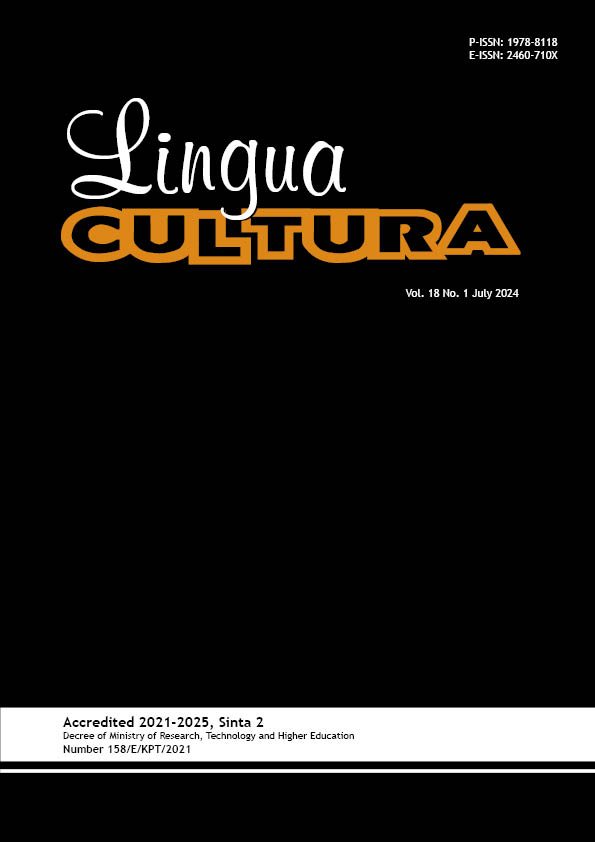Expressive Speech Act of British and American Culinary Review: A Cross-Cultural Pragmatics Study
DOI:
https://doi.org/10.21512/lc.v18i1.10669Keywords:
expressive speech acts, culinary review, British communities, American, cross-cultural pragmaticsAbstract
The research was conducted to uncover how American and British high school students utilize expressive speech
acts for each other’s culinary representation. It examined the linguistic and cultural manifestations in which reviewers communicated their personal opinions and attitudes toward food. The research applied a descriptivequalitative approach using Searle’s theory of the illocutionary point of speech act, which comprised the pragmatical characteristics focusing on the spoken form expression from both cultures. The data were collected from two video blogs from a YouTube channel called ‘Jolly’, with the title “British high-school students try American biscuits and gravy for the first time†and “Americans eat British comfort food for the first time†by using listening and note-taking techniques on the expressive speech act that occurred from the transcript of the video blog. The results show that both American and British high school students have expressive speech acts of surprise, preference, and disbelief. Yet, the unique traits of both cultures can be noticed in the way Americans express disgust while the British express humor.
References
Akkilinç, F. (2018). The importance of navigating cultural differences and comprehending cross-cultural communication. Journal of International Social Research, 11(59), 607-613. https://doi.org/10.17719/jisr.2018.2666.
Argyris, Y. A., Monu, K., Kim, Y., Zhou, Y., Wang, Z., & Yin, Z. (2021). Using speech acts to elicit positive emotions for complainants on social media. Journal of Interactive Marketing, 55(1), 67-80. https://doi.org/10.1016/j.intmar.2021.02.001.
Back, R. M., Okumus, B., & Tasci, A. D. A. (2020). Culinary fans vs culinary critics: Characteristics and behavior. International Hospitality Review, 34(1), 41-60. https://doi.org/10.1108/ihr-10-2019-0024.
Beeman, W. O. (2014). Emotion and instantaneous choice in interactional linguistic pragmatics: Cross-cultural perspectives. Journal of Pragmatics, 69, 52-62. https://doi.org/10.1016/j.pragma.2014.04.007.
Chen, G., Li, Y., & Sun, Y. (2023). How YouTubers make popular marketing videos? Speech acts, move structure, and audience response in YouTube influencer marketing videos. SAGE Open, 13(1), 1-14. https://doi.org/10.1177/21582440231152227.
Hjerm, M., Eger, M. A., Bohman, A., & Fors Connolly, F. (2020). A new approach to the study of tolerance: Conceptualizing and measuring acceptance, respect, and appreciation of difference. Social Indicators Research, 147(3), 897-919. https://doi.org/10.1007/s11205-019-02176-y.
Lacsina, N. E. H. (2023). Unveiling the art of food vlogging: A multimodal discourse analysis of food review vlogs. International Journal of Linguistics and Translation Studies, 4(2), 11-25. http://dx.doi.org/10.36892/ijlts.v4i2.319.
Mabaquiao, J. M. M. (2018). Speech act theory: From Austin to Searle. Augustinian: A Journal for Humanities, Social Sciences, Business, and Education, 19(1), 34-45.
Mahsun, M. (2017). Metode penelitian bahasa: Tahapan, strategi, metode, dan tekniknya. Depok, Indonesia: Rajawali Pers, PT RajaGrafindo Persada.
McConachy T, Spencer-Oatey H. Cross-cultural and intercultural pragmatics. In M. Haugh, D. Z. Kádár, & M. Terkourafi (eds), The Cambridge Handbook of Sociopragmatics (pp. 733-757). Cambridge, USA: Cambridge University Press.
Ngasini, N., Senowarsito, S., & Nugrahani, D. (2021). An analysis of expressive speech acts used in Ellen Show “Interview with Billie Eilishâ€. Applied Linguistics, Linguistics, and Literature (ALLURE) Journal, 1(1), 53-62. https://doi.org/10.26877/allure.v1i1.9213.
Nurhayati, E., & Prasetiyo, A. B. (2022). Variasi tindak ilokusi dalam tuturan food vlogger Farida Nurhan di YouTube. Barista : Jurnal Kajian Bahasa Dan Pariwisata, 9(1), 31-45. https://doi.org/10.34013/barista.v9i01.647.
Pangesti, N. I. (2019). Tindak tutur ekspresif di akun instagram @kampuszone. Hasta Wiyata, 2(2), 33-40. https://doi.org/10.21776/ub.hastawiyata.2019.002.02.04.
Pascual, D. (2021). Speech acts in travel blogs: Users’ corpus-driven pragmatic intentions and discursive realisations. Elia, 21, 85-123. https://doi.org/10.12795/elia.2021.i21.04.
Rahmawati, R. D. (2021). An analysis of expressive speech acts used in Crazy Rich Asian movie. Journal of Language and Literature, 9(1), 83-94. https://doi.org/10.35760/jll.2021.v9i1.2961.
Rais, B., & Triyono, S. (2019). Pragmatic analysis of speech acts on the video of Prabowo vs Jokowi - Epic rap battles of presidency. International Journal of Linguistics, Literature, and Translations, 2(3), 150-157. http://dx.doi.org/10.32996/ijllt.2019.2.3.17.
Saifudin, A. (2019). Teori tindak tutur dalam Studi Linguistik Pragmatik. LITE, Jurnal Bahasa, Sastra, dan Budaya,15(1), 1-16. https://doi.org/10.33633/lite.v15i1.2382.
Searle, J. R. (1980). In J. R. Searle, F. Kiefer, & M. Bierwisch (eds), Speech act theory and pracgmatic. Dordrecht, Netherlands: D. Reidel Publishing Company.
Searle, J. R., & Vanderveken, D. (1985). Foundations of illocutionary logic. Cambridge, USA: Cambridge University Press Archive.
Wulandari, K. S., Ngatmini, N., & Utami, H. R. (2023). Daya pragmatik tuturan food-vlogger Bara Ilham pada saluran Youtube Tanboy Kun. Sasindo: Jurnal Pendidikan Bahasa dan Sastra Indonesia, 11(2), 215-229. https://doi.org/10.26877/sasindo.v11i2.16149.
Downloads
Published
How to Cite
Issue
Section
License
Copyright (c) 2024 Annisa Kharismi

This work is licensed under a Creative Commons Attribution-ShareAlike 4.0 International License.
Authors who publish with this journal agree to the following terms:
a. Authors retain copyright and grant the journal right of first publication with the work simultaneously licensed under a Creative Commons Attribution License - Share Alike that allows others to share the work with an acknowledgment of the work's authorship and initial publication in this journal.
b. Authors are able to enter into separate, additional contractual arrangements for the non-exclusive distribution of the journal's published version of the work (e.g., post it to an institutional repository or publish it in a book), with an acknowledgment of its initial publication in this journal.
c. Authors are permitted and encouraged to post their work online (e.g., in institutional repositories or on their website) prior to and during the submission process, as it can lead to productive exchanges, as well as earlier and greater citation of published work.
USER RIGHTS
All articles published Open Access will be immediately and permanently free for everyone to read and download. We are continuously working with our author communities to select the best choice of license options, currently being defined for this journal as follows: Creative Commons Attribution-Share Alike (CC BY-SA)


















